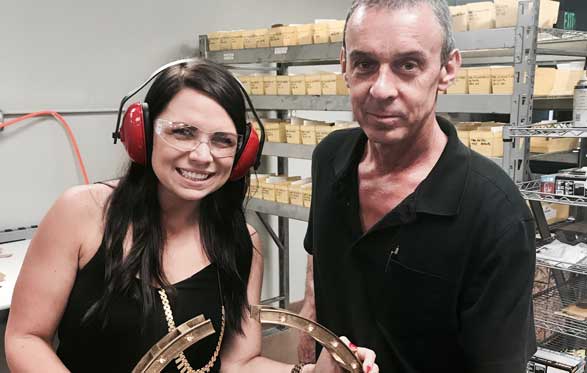Why does a computational software company need a physical test lab anyways?
I had the opportunity to spend the day with LeRoy Smith, Sentient Science Lab Technician taking a deep dive into Sentient’s materials lab. The lab, located in West Lafayette Indiana is just a few steps away from Purdue University, which makes our team feel right at home. After all, more than 60% of the scientists have the pleasure of calling Purdue their alma mater!
The lab is the first and perhaps one of the most critical steps in Sentient Science’s computational process of predicting component failure in rotating equipment. Operators and OEMs in the Wind, Aerospace, and Rail communities use DigitalClone Live to extend asset life, reduce risk and cost. The software uses a unique materials-based approach to generate specific life extension actions for each customer depending on the current health state of each unique asset. The platform helps optimize supply chain costs by connecting operators and suppliers to enable new business streams.
Historically, OEMs and suppliers have been reluctant to provide a 3rd party company such as Sentient Science with their detailed component data. However, DigitalClone Live is a tool that takes proprietary data, anonymizes it and enables supplier access to new business opportunities for their product offerings through the DigitalClone operator network. For example, a wind turbine operator can simulate how a new gearbox type would impact the life of their asset, under real operating conditions. Customers use the software to optimize the supply chain process and reduce costs.
LeRoy’s main function in the lab is to extract data from physical samples provided by Sentient customers. He calls this, materials processing, where he processes each individual bearing or gear into sample pieces for further computational analysis and testing within the DigitalClone Live environment.
Let’s hear more from the Lab professional himself.
When did you start working at Sentient?
In January, it’ll be one year. I’ve been keeping a “low profile” since then. The lab is growing very quickly, I look forward to making it more efficient. The more components and materials the lab processes, the more the computational library grows which helps to expand the application of DigitalClone Live. I’ve recently hired an intern, David Murzyn, from Purdue University to help keep up with the high demand of the lab.
What did life look like before Sentient? What attracted you to this position?
I was in the sealing division at federal mogul for 13 years, it was a great transition because seals and bearings are very parallel. Then I moved into TRW in the Ford lab. I loved the idea of processing materials and components to understand the microstructure analysis. This job is a very important step in understanding why components fail analysis how to make them last longer.
What’s your favorite part about leading the efforts in the lab?
I like the environment, the challenge and the attention to detail. This work is an extremely important step in the DigitalClone Live predictions. It’s the first step in the process of transferring the physical data and knowledge into digital data. It has to be done right the first time to feed into the further steps in the analysis.
What type of data are you looking for?
We are looking for the geometries of the bearings and gears. We do this through precision measurement and profilometry scans, then digitize the information to feed it into the Sentient databases.
What’s the most interesting tool in the lab?
I’d have to say the profilometry machine, we use the Zygo brand. The machine measures surface finish and generates 3D models of magnified surfaces.
What motivates you inside the lab?
I refer to it as “Lab Music” …..most people refer to it as classical music. The tone of this music creates a very calming environment that I can concentrate in. There is a lot of important steps going on in the lab at once, this helps me focus on one process. Outside of the lab, I like heavy metal, you know the kind of music that makes you drive fast.
How’s the dynamic with your team?
About 80% of the employees at Sentient work in a digital world and I live in a physical world every day. The software computer team complements the work I’m doing very well. The communication has been so awesome, there is usually a big divide with a dynamic like this.
How does the lab stay innovative in such a fast pace industry?
We created something we call the lab initiative group with five team members, all responsible for different functions and objectives in the assembly of the lab. The core goal of this group is to focus on productivity, efficiency, and cost analysis.
To learn more about DigitalClone Live and examples of how Sentient is digitizing rotating equipment, read the cause study on Duke Energy here.
